Diseases and pests of parsley: photos, methods of control and prevention
Fragrant and juicy parsley will decorate any dish: soup, salad, side dish or appetizer. They collect it all summer, part of it is dried or frozen, part is consumed fresh. To get a rich and tasty harvest of greens, follow the rules of crop rotation and care, regularly take preventive measures to protect the plant from diseases and pests.
The article contains the most common and dangerous diseases and pests of parsley with photos and descriptions, effective methods of combating and preventing diseases.
The content of the article
Diseases of parsley
Diseases occur due to sudden changes in weather, prolonged rains and fogs. The reasons are improper care, non-compliance with the rules landing, contaminated soil and seeds. In order to effectively combat a disease, it is important to recognize it at the very beginning of infection.
Powdery mildew
Fungal disease that occurs due to a lack or excess of nutrients and weak immunity. The sources of the disease are infected plant debris, unprepared soil. The fungus actively spreads during periods of heat and rains, the infection begins from the bottom and in a few days the entire parsley bush becomes covered with a white-gray bloom. Over time, dense dark brown balls and ulcers appear on the stem and leaves.
For prophylaxis, spraying the beds with a solution based on milk whey is used. The main thing is to detect powdery mildew at the initial stage of infection in order to prevent its further spread. Otherwise, the parsley crop will be lost.
Rust
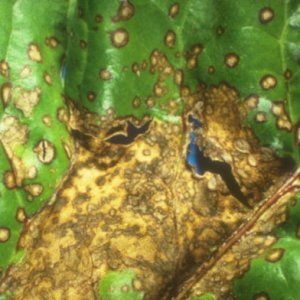
The disease got its name from the dark brown and yellow spots that appear on the leaf plates.
The diameter of the spots is about 0.5 cm, some grow up to 1 cm. The causative agent of the disease, a fungus, is dangerous not only for parsley, but also for dill and celery.
Rust is terrible in that the infected leaves lose their taste and marketability, they are not suitable for eating.
As a preventive measure for planting, disinfected seeds are used and the soil is disinfected, irrigated with warm water. Once a week, the beds are sprayed with Bordeaux liquid or copper sulfate solution.
Attention! A solution of copper sulfate is easy to make yourself. For 10 liters of water, 50 g of powder is required. Hot water is poured into a plastic deep container and the powder is poured, stirred thoroughly and cooled. Such a prophylactic agent will help avoid the appearance of powdery mildew and other fungal diseases.
Fomoz
The disease is typical for regions with unstable climatic conditions. Dark purple stripes and spots appear on the plant, the leaves become gray, become lethargic and faded. Infected specimens die off, the disease spreads to nearby plants. The taste and appearance of parsley is deteriorating, and it is almost impossible to save infected beds.
For prophylaxis, spraying with a solution based on dry wood ash is used; the drug Fundazol is used as a remedy. Observe the dosage indicated on the package. When buying, check the expiration date.
Variegated dwarfism
A viral disease appears in the beds due to insect vectors. Parsley leaves become deformed, shrink and curl.At the edges, they change color and fade.
For prevention, the rules of crop rotation are observed and the beds are regularly weeded to protect against insects. Treat variegated dwarfism with Bordeaux liquid.
Alternaria
Black rot occurs not only on parsley, but also on nearby planted carrots and celery. Often these crops are the source of infection. The root collar of the stem darkens, becomes wet and becomes covered with a dark bloom. After a few days, the leaves turn yellow and dry out, the plates are covered with yellow-green dense specks.
Black rot actively spreads during humid and foggy summers. For prophylactic and therapeutic purposes, use the "Topaz" product. During processing, personal safety rules are observed: wear protective gloves, goggles and a respirator.
White rot
White bloom and black spots appear on the parsley. The causative agent of white rot is a fungus that appears on adjacent beds of tomatoes, cabbage and bell peppers. The fungus is tenacious, persists at low temperatures in the soil for up to three years.
They carry fungus and insects, so it is recommended to regularly weed the beds and remove weeds. It is impossible to cure white rot, the affected plants are thrown away and burned. For preventive purposes, spraying with ash and a solution of milk with iodine is used. These folk remedies strengthen the immunity of cultures.
Jaundice
This viral disease spreads in all climates. The leaves are covered with a yellow bloom, the stems grow in different directions, the bush becomes like a broom. The virus is transmitted through insects, plant debris or weeds.
As a preventive measure for planting, virus-resistant varieties are used, for example, Freska or Element, they follow the rules of disinfection and crop rotation.
Spotted bacteriosis
The causative agents of the disease are bacteria that develop in greenhouses and open ground. Yellow and white spots appear on the greenery, which turn brown after a few days, the leaves dry out. Such a crop is not suitable for consumption.
The peculiarity of spotted bacteriosis is that the bacteria live in cold soil. Prevention of the disease consists in processing the beds before sowing, treating the disease with the drug "Quadris".
Pests
Pest insects appear regardless of the weather. And if in the beds with potatoes the regular guests are Colorado beetles, then parsley is affected by aphids, leaf flies, carrot flies and others.
Aphid
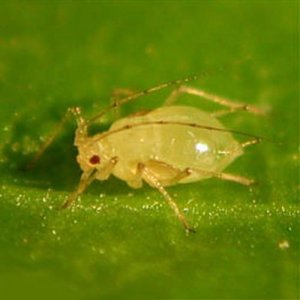
Small white flying bugs live in flocks. They are located on the inside of the sheet, so it is difficult to see them with the naked eye. The size of the bug is only 2 mm, color - from white to dark brown and yellow.
Both larvae and adults do harm. Aphids suck juice from parsley, which leads to wilting and death of the plant. The insect carries infections and fungi.
In the fight against the pest, treatment with the drug "Quadris" or a solution of copper sulfate helps.
Beetle leaf
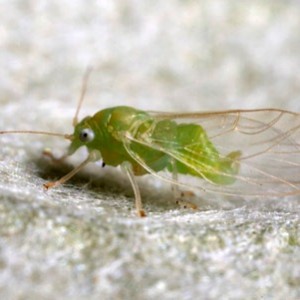
The light green leaf beetle sucks nutrients out of the parsley. The leaves become deformed and wither, acquire a faded green tint, lose their taste and marketability.
For prevention, gardeners regularly water the beds with warm water, before each watering, remove weeds and loosen the soil.
The drug "Profit" will help to get rid of the lice beetle.
Stem nematode
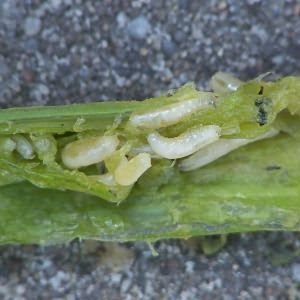
Thin and long filamentous worms infect young plants and adult specimens.
The nematode hibernates in the soil and appears on plants in early summer.
Parsley infected with a pest begins to rot and weaken. The leaves are covered with spots and chaotic stripes of various sizes.
Gardeners monitor the cleanliness of the beds, regularly inspect the plants.
The infected parsley is removed and burned, and the remaining specimens are treated with the "HOM" preparation.
Attention! An effective method of treatment is heat treatment of the roots.Affected parsley is removed from the soil and washed from the soil. The roots are immersed in water at a temperature of at least 50 ° C, at which the nematode dies. The procedure is safe for the plant.
Carrot fly
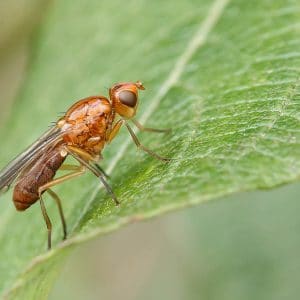
The insect is only 5 mm long, so the carrot fly is easily hidden from human eyes. Parsley is attacked by larvae or adults. The pest lives on leaves and stems, due to which the latter acquire an unnatural dark purple hue and become covered with ulcers.
The carrot fly reproduces and develops rapidly, so it is easier to prevent its occurrence than to fight it.
As a preventive measure, it is recommended to follow the rules of crop rotation, not to plant parsley in the same place for more than two years in a row. For planting, choose a dry, fertile and well-ventilated place.
Control methods
All methods of struggle are divided into three groups: chemical, folk and biological. Let's consider each in detail, identify its advantages and disadvantages.
Chemical
Chemical methods are effective and fast, but they can be harmful to humans. Therefore, it is recommended to spray with chemicals no later than a month before harvesting, observe safety measures during processing, use gloves and safety glasses:
- against powdery mildew, spraying with colloidal or ground sulfur helps;
- rust is treated with a solution of Bordeaux liquid;
- phomoz eliminates copper oxychloride;
- from pests help drugs "Iskra", "Confidor Extra", "Intavir".
Biological
Biological methods suppress the development of diseases and pests, and are safe for humans. Planting "medicinal plants" is effective in the fight against fungal and viral diseases. Marigolds will protect greens from nematodes, and onions from carrot flies.
The biological methods also include the attraction of nurse insects. For example, larvae and adult ladybugs destroy aphids. And black garden ants eat stem nematode larvae.
Folk
Folk methods common among gardeners are simple to perform. They are especially effective as a preventive measure or for controlling diseases and pests at the initial stage of infestation:
- to protect against aphids, the beds are sprinkled with tobacco dust;
- spraying with dandelion infusion helps to get rid of the leaf flies;
- infusion of garlic destroys the carrot fly;
- onion solution helps against viral and fungal diseases;
- infusion of tobacco eliminates nematodes.
Preventive measures
Before planting, parsley seeds are etched with a solution of potassium permanganate. It kills pathogenic microflora on the surface of the material and strengthens the immunity of the future plant. The beds for greenery are chosen loose and nutritious. Parsley is planted after cucumbers, berries or between rows. It is not recommended to plant it after last year's parsley or carrot harvest.
Sprinkle greens with warm water in the morning or evening to avoid sunburn. Once a week, they are sprayed with protective folk or chemical solutions. Inspect regularly for pests or diseases. Before each watering, the soil is loosened, this kills the larvae and improves the microflora of the beds.
Attention! When planting parsley in a greenhouse, observe the regime: air temperature no more than + 20 ° C. The room is regularly ventilated, treated with a sulfur checker before planting, and the walls and doors are wiped with a solution of potassium permanganate.
Why does parsley turn yellow
Why does parsley turn yellow in the garden? The reasons are irregular watering, lack or excess of mineral and organic fertilizing, diseases and pests. Particular attention is paid to balanced nutrition: feeding is carried out every 15 days, alternating between mineral and organic substances.
Excess or deficiency of nitrogen, calcium, potassium, phosphorus leads to yellowing. Another reason is acidic soil. The problem is solved with liming.Before planting, they dig up the beds and sprinkle with dry lime and wood ash.
Why white spots appear
White spots appear due to a lack of minerals, the development of white rot or powdery mildew. In the first case, it is recommended to feed the parsley with ammonium nitrate, nitrophos, potassium salt. In the second - to carry out therapeutic measures, to process herbs with chemical or folk remedies.
Attention! Is it okay to eat parsley with yellow or white spots? No, it is dangerous to health, as the color signals changes in the chemical composition of the greenery and its properties. The yellowed leaves have lost their juice, they do not contain vitamins useful for health.
Conclusion
Fresh and juicy parsley is always in place. It is easy to grow it if you follow the rules of crop rotation and take care of the crop in accordance with agrotechnical standards. Separately, there are preventive and therapeutic methods that prevent the development of fungal and viral diseases, and destroy pests.
Gardeners recommend treating the beds with tobacco powder, Bordeaux liquid and copper sulfate solution.